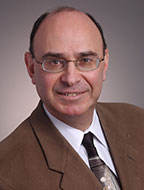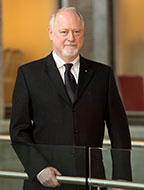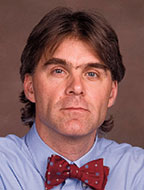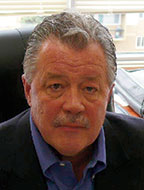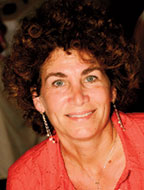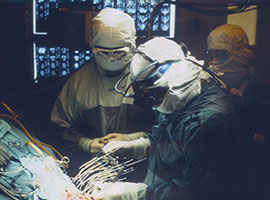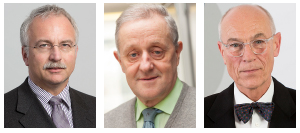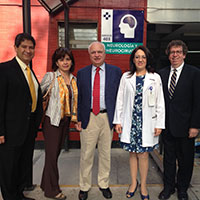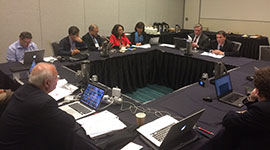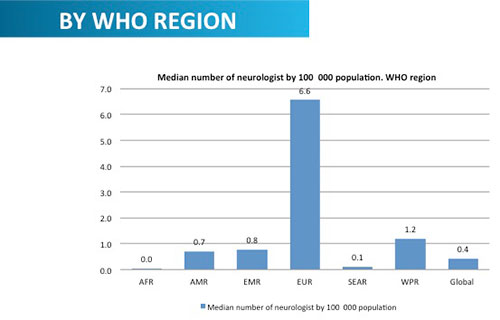By Jacques Reis, MD, Serefnur Öztürk, MD, Gustavo C. Román, MD, and Peter Spencer, PhD
We present here a brief overview of the history of the creation of the Environmental Neurology Applied Research Group (ENRG) of the World Federation of Neurology (WFN).
World Congress of Neurology, Sydney, 2007

JACQUES REIS, MD
After the session of the Neurotoxicology Research Group, Leon Prockop, Tampa, Florida, acting as chair of this group, gathered people interested in the field of neurotoxicology. We were few. Our goals were to better fit with the new challenges in our field. Peter S. Spencer, Oregon Health and Science University, Portland, proposed expanding the goals of the group and pointed to the interaction between genes and environment. Jacques Reis, a clinical neurologist at the University of Strasbourg, France, presented the experience and success of a new and small French group, Le Club de Neurologie de l’Environnement, created in 2003. Prockop liked the idea of gathering energies around the charismatic word, “environment.” We hoped to bring a new and powerful concept to neurology, which would be able to amalgamate researchers in fields related to the environment (e.g., neuroepidemiology, tropical neurology, nutrition, and neurotoxicology). The decision to modify the name of the Neurotoxicology Research Group to the ENRG was taken. Prockop‘s proposal was accepted by the WFN. Donna Bergen of the WFN Research Committee actively supported the newly born group.
For the first time, a neurologic academic international federation had put the environment on its agenda. Prockop was the chair, and Reis served as co-chair and link with Le Club de Neurologie de l’Environnement. Each year, the club offers two sessions of review topics on environmental neurology to general neurologists during the Journées de Neurologie de Langue Française, the worldwide meeting of French-speaking neurologists. The club is connected with neurologists and neuroscientists from Quebec, Oran, Algeria, Tunisia, and Luxemburg.
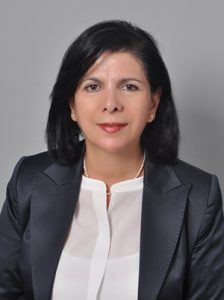
SEREFNUR ÖZTàœRK, MD
Thus, 2007 was a wonderful year that saw the founding of the ENGR. This was crowned with the publication of a successful special issue of the Journal of the Neurological Sciences, the official publication of the WFN, on “Environmental Neurology: A Promising New Field of Practice and Research,” edited by Gustavo C. Román, Reis, Gilles Defer, and Prockop (J Neurol Sci Nov. 15, 2007; 262 (1-2):1-174). This issue contained the proceedings of the meetings of Le Club de Neurologie de l’Environnement held in Paris, France, Dec. 2-3, 2005, and in Metz, France, Feb. 7, 2007, under the aegis of the French Society of Neurology, the University of Metz, and the ENRG.
This publication greatly contributed to better define this new research field, but the challenges for the ENRG are huge. As for clinical neurotoxicology, there is still no teaching on this topic available anywhere in the world. We have to explain, to persuade and to raise interest in other fields of neurology, of course without any support from the regular neurological partners. Furthermore, experts in these fields are rarely neurologists. Prockop, Román, Spencer, and Reis have become advocates for the ENRG when invited to talk by the Société Française de Neurology (Paris, France), by the Association des Journées de Neurologie de Langue Française, or by the International Neurotoxicological Association, Porvoo, Finland.
Lorraine, France, June 2009
The first meeting organized by the ENRG took place in Sarreguemines, a small city of east France, near the German border. We gathered, with the collaboration of Le Club de Neurologie et Environnement, well known scientists under the presidency of Prockop and Bertrand Rihn, Nancy, France. The ENRG session was dedicated to genetics, neurodevelopmental, and neurotoxicological topics. The titles of the talks were: “Genes and Environment in the Pathogenesis of Parkinson’s Disease,” presented by Rejko Krüger, University of Tübingen and now at the University of Luxembourg; “Epigenetics,” presented by Massimo Pandolfo, Brussels Free University, Belgium; “Developmental Aspects of Environmental Neurotoxicology,” presented by Gerhard Winneke, Heinrich-Heine-Universität, Düsseldorf; “Multiple Sclerosis Oligoclonal IgG and the Environment, the Vital Clue,” presented by Frederick Gay, Oxford, United Kingdom; and “Carbon Monoxide: The Under-Noticed Poison of the 21st Century,” presented by Prockop.
World Congress of Neurology, Marrakech, 2011
Prockop and Reis were on the program with topics related to CO intoxication and neurological consequences of climate change in two sessions dedicated to the environment, culture, and neurosciences. Román addressed neuroepidemiological issues, and other talks explored different issues of interest to ENRG. Our business meeting gathered people from Africa and Asia interested in environmental neurology. Building a new research group is a real challenge, especially when the field is completely new and has neither academic nor financial support.
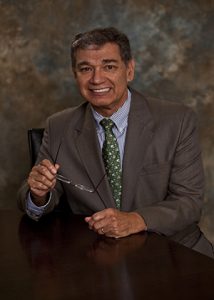
GUSTAVO C. ROMàN, MD
ICNE 2, Nice, France, 2012
Professor Valery Feigin, Auckland, New Zealand, chair of the International Congress on Neurology and Epidemiology, invited the ENRG to run a symposium during the Congress. For the first time, our group organized a joint meeting, sharing common themes with neurologists and epidemiologists. Our satellite symposium answered a common question: What is an environmental factor? An introduction to the topic was provided by Reis. Spencer lectured on when the environmental factor appears multifactorial: nodding syndrome, and Walter Rocca, Mayo Clinic, discussed the role of pesticides and risk of Parkinson’s disease.
World Congress of Neurology, Vienna, 2013
For the first time, our group was on the official program and managed two sessions. Roman and Reis invited an international panel of speakers who tackled some aspects of environmental neurology, including “Space Medicine,” presented by F. Gerstenbrand, Austria; “Environmental Intolerance and Multiple Chemical Sensitivity,” presented by Reis; “Neurotoxic Effects of Solvents and Nanoparticles,” presented by G. van der Laan, the Netherlands; “Stroke and Weather Association,” presented by Feigin; “The Fukushima Earthquake,” presented by Y. Ugawa, Japan; and “The Spread of the West Nile Virus,” presented by Román. The success of this meeting was crowned by an article that appeared in the special issue of Neurologisch, the official journal of the Austrian Society of Neurology; Román and Reis summarized the different talks (Kongress-Highlights, Neurologisch 2013). Our business meeting followed, and we gained support from leading members of the WFN board.
ICNE 3, Abu Dhabi, 2013
The ENRG contributed to this meeting with a satellite symposium. We kept expanding on the notion of environmental factors. With three talks, we focused on time-related issues of some environmental factors: “When and How Do Environmental Factors Act on Living Organisms?” presented by Reis, “Epigenetic and Environmental Determinants of Tauopathies,” presented by N. Zawia, University of Rhode Island, Providence, and “Early Life Risk Factors in Parkinson’s Disease,” presented by G. Logroscino, Bari, Italy.
Collaboration With the Applied Research Group on Nutrition and the Central Nervous System and the World Health Organization, 2014
In March 2014, Professor Marco T. Medina, Tegucigalpa, Honduras, invited our group to participate to the working group on nutritional and toxic disorders of the nervous system to improve the International Classification of Diseases-11, edited by the WHO.
ICNE 4, Kuala Lumpur, 2014
Our third symposium was dedicated to global environmental factors. We tackled “The Boomerang Effect: Health Risks (for the brain) from Global Change” with two speakers, Reis and Spencer.
World Congress of Neurology, Santiago de Chile, 2015
The ENRG managed one session. We addressed three important topics, which are beginning to gain widespread attention: “Air Pollution and the Neurological Impact,” presented by L. Calderon-Garciaduena, Missoula, Montana, “New Promising Hypotheses for the Nodding Syndrome,” presented by Spencer, and “Multiple Sclerosis,” presented by Reis.
Antalya, Turkey, 2015
Reis has been invited by Professor Serefnur Öztürk on behalf of the Turkish Neurological Society (TNS) to give two talks related to environmental neurology, one about global warming and neurological consequences and the second about the bacterial hypothesis of multiple sclerosis. For the first time, the Turkish Neurological Society, under the presidency of Öztürk, had proposed a workshop on “Occupational Diseases, Neurology, and Environmental Health.” Two other topics were dedicated to “Coal, Clean Air Rights, and the TNS,” presented by Semih Ayta, Istanbul, and “Occupational Diseases,” presented by Ibrahim Akkurt, Ankara.
2015 was an important year. The TNS had begun a partnership with a Non-Governmental Organization in a platform dedicated to global challenges, notably coal energy, air pollution, and global warming. This important issue is challenging the WFN and all medical associations. What should we do? What is possible? How do we do it? Should we be acting as experts? Is a greater commitment acceptable and necessary?
Overview of Facts in Environmental Neurology: The Goals of the ENRG
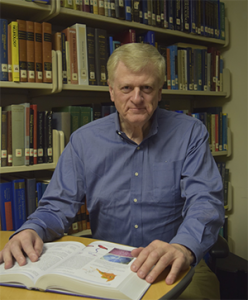
PETER SPENCER, PHD, FANA, FRCP
The importance of environmental risk factors is well accepted in all health and medical fields. Risk factors may include all external factors that adversely impact normal neurological function, whether acting in isolation or in concert with an intrinsic factor, such as malnourishment. External (extrinsic) factors include a wealth of physical, chemical, and other stressors that may act alone or in concert with an internal factor, such as a covert genetic susceptibility. This subject is of particular relevance in the search for the majority of neurodegenerative disorders in which gene-environment causation is widely acknowledged, but the latter is rarely subjected to intensive research. Indeed, a 2015 WHO research prioritization exercise focused on dementia stated the need to “understand the contribution of environmental factors to neurodegenerative diseases causing dementia and their interaction with other pathophysiological processes at the epigenetic, molecular, and systems levels.”
Recognition that environmental science is involved in understanding mainstream neurological diseases, in addition to the plethora of regional disorders relating to physical extremes (heat, cold, height, depth), nutritional challenges, and diverse exposures to chemical and biological agents, indicates the importance for neurology to nourish the nascent and multidisciplinary science of environmental neurology.
At the present time, neurologists face the foregoing medical challenges with virtually no relevant training. There are no special education courses available for neurologists. While the adverse effects on the nervous system of alcohol and other drugs are known, as are the relevant side effects of medications with neurotoxic potential, there is no formal study of neurotoxicology, despite the availability of several compendia on the topic. Additionally, neurologists may not be skilled in understanding and deciphering the interactive effects on the brain of multiple extrinsic factors, let alone the knowledge to launch an in-depth investigation of environmental contributions to the genesis of neurodevelopmental disorders, neurodegenerative disease, vascular dementia, epilepsy, or central nervous system malignancies.
While we recognize these training deficiencies, many neurologists pay only lip service to the role of environmental factors in neurological disease. Most significantly, the poverty of research funds provided by granting agencies toward increasing knowledge on environmental factors and research on a wide range of neurological disorders is a major concern. From the WFN, the ENRG will continue to face these challenges and to increase the overall support among neurologists.
We intend to address these education and training deficiencies through an expansion of ENRG and by interacting with diverse neurology groups interested in this topic, as well as with other biomedical disciplines. There is a real need to satisfy these demands at the international level. Expanding our base is needed to advance the discipline of environmental neurology. This is our goal. To achieve this goal, it will be necessary to interact with other research groups because none has either the human weight or the financial strength to act in isolation. WFN could put on its agenda the environment. Our proposal is, for example, to organize during the next Congress a Day of the Environment. All research groups interested in and dealing with environmental neurology could interact easily, and the visibility among Congress attendees would increase.
To face these challenges and the exciting potential to broaden and deepen the education, understanding, and research impact of neurology, the ENRG needs and requests the help of the WFN, which for neurology is the only institution that can promote these views.
If anyone is interested in joining our group, participants, and countries, please contact the authors. We are also pleased to invite you to the first ENRG meeting in Strasbourg (Nov. 30-Dec. 1, 2016).
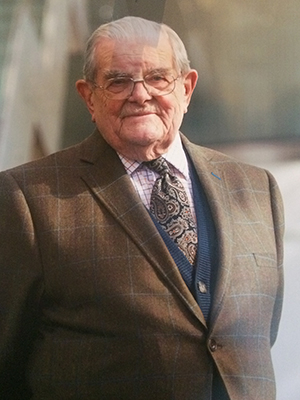 The World Federation of Neurology is remembering John Nicholas Walton, MD, who passed away in April at the age of 93. Walton, who served two terms as president of the WFN following his election in 1989, knew the organization better than anyone. His work in the WFN started from its inception in 1957. He succeeded Macdonald Critchley as editor of the Journal of Neurological Sciences when Critchley later became WFN president in 1965. He worked with Henry Miller as secretary general to shape the organization. Walton saved the WFN from bankruptcy with his compromise during the creation and later dissolution of the World Association of Neurological Commissions (WANC), which resolved the financial crisis of the WFN in 1966. He started the research group on neuromuscular disorders. He was elected first vice president during Richard Masland´s presidency. During this busy time at the WFN, he wrote Essentials of Neurology, which became a standard textbook for medical students. In 1968, he was promoted to a personal chair in neurology at England’s Newcastle University, and in 1971 he was appointed dean of the Newcastle Medical School. He was knighted in 1979, was appointed life peer in 1989 as Baron Walton of Detchant, and he sat in the House of Lords as a crossbencher.
The World Federation of Neurology is remembering John Nicholas Walton, MD, who passed away in April at the age of 93. Walton, who served two terms as president of the WFN following his election in 1989, knew the organization better than anyone. His work in the WFN started from its inception in 1957. He succeeded Macdonald Critchley as editor of the Journal of Neurological Sciences when Critchley later became WFN president in 1965. He worked with Henry Miller as secretary general to shape the organization. Walton saved the WFN from bankruptcy with his compromise during the creation and later dissolution of the World Association of Neurological Commissions (WANC), which resolved the financial crisis of the WFN in 1966. He started the research group on neuromuscular disorders. He was elected first vice president during Richard Masland´s presidency. During this busy time at the WFN, he wrote Essentials of Neurology, which became a standard textbook for medical students. In 1968, he was promoted to a personal chair in neurology at England’s Newcastle University, and in 1971 he was appointed dean of the Newcastle Medical School. He was knighted in 1979, was appointed life peer in 1989 as Baron Walton of Detchant, and he sat in the House of Lords as a crossbencher.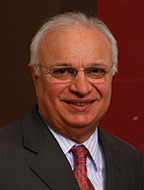
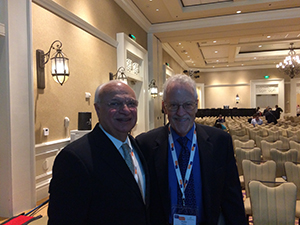
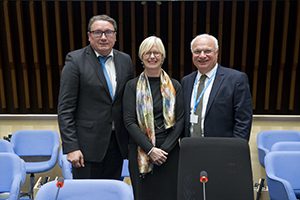
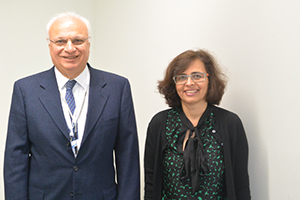
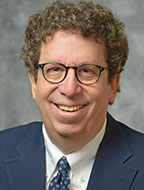
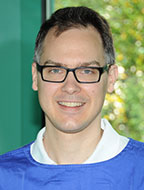
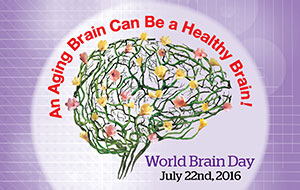
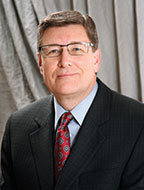
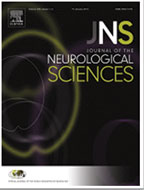 WHO has convened several meetings to address the Zika virus epidemic. Several WHO peer-reviewed guidelines have been generated. WHO is posting these guidelines and is providing frequent updates about the Zika virus situation on its website. WHO provides the most comprehensive global information on Zika virus, and I encourage everyone to visit the WHO website,
WHO has convened several meetings to address the Zika virus epidemic. Several WHO peer-reviewed guidelines have been generated. WHO is posting these guidelines and is providing frequent updates about the Zika virus situation on its website. WHO provides the most comprehensive global information on Zika virus, and I encourage everyone to visit the WHO website, 